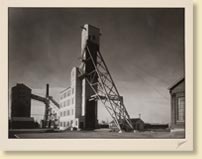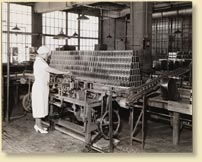The Collection: Data Analysis
Photography has the capacity for accounting for things seen in the visual world with an exactitude for their differences which no other medium can approximate.Charles Sheeler, 1923
 Ayres and Davenport were doggedly systematic in amassing images that illustrated workers in a variety of manufacturing operations. They also gathered expansive views of factory exteriors and research laboratories, as well as close-ups of equipment and products. In all, Ayres and Davenport acquired more than 2,100 photographs (dating from the 1920s to the early 1940s) from 115 businesses, including some foreign companies. Concurrently with their collecting efforts, Charles H. Taylor, a founding member of the Business Historical Society, and J. T. Sullivan, automotive editor and writer for the Boston Globe, solicited from automobile manufacturers images advertising their new models. Students could reference more than 2,000 photographs included in the automobile industry collection as well.
Ayres and Davenport were doggedly systematic in amassing images that illustrated workers in a variety of manufacturing operations. They also gathered expansive views of factory exteriors and research laboratories, as well as close-ups of equipment and products. In all, Ayres and Davenport acquired more than 2,100 photographs (dating from the 1920s to the early 1940s) from 115 businesses, including some foreign companies. Concurrently with their collecting efforts, Charles H. Taylor, a founding member of the Business Historical Society, and J. T. Sullivan, automotive editor and writer for the Boston Globe, solicited from automobile manufacturers images advertising their new models. Students could reference more than 2,000 photographs included in the automobile industry collection as well.
 The Business School’s activities followed a pattern of collecting practices found elsewhere at Harvard. Throughout the university’s expanding libraries, museums, and research departments, photographs were acquired to support research and teaching in newly emerging disciplines. Like other fields in the sciences and humanities, business administration was developing into a formalized area of study that required analysis of data based on observation. Photographs would aid classes being taught by the “case method,” an instructional concept employed by the Business School in the 1920s whereby students solved problems by studying real-life business situations. The Bulletin of the Business Historical Society concurred that photographs were “especially valuable in the industrial management classes because they portray so clearly such practical industrial problems as the relationship between the laborer and the machine.”
The Business School’s activities followed a pattern of collecting practices found elsewhere at Harvard. Throughout the university’s expanding libraries, museums, and research departments, photographs were acquired to support research and teaching in newly emerging disciplines. Like other fields in the sciences and humanities, business administration was developing into a formalized area of study that required analysis of data based on observation. Photographs would aid classes being taught by the “case method,” an instructional concept employed by the Business School in the 1920s whereby students solved problems by studying real-life business situations. The Bulletin of the Business Historical Society concurred that photographs were “especially valuable in the industrial management classes because they portray so clearly such practical industrial problems as the relationship between the laborer and the machine.”
- Baker Library | Historical Collections | Site Credits | Digital Accessibility
- Contact Email: histcollref@hbs.edu
